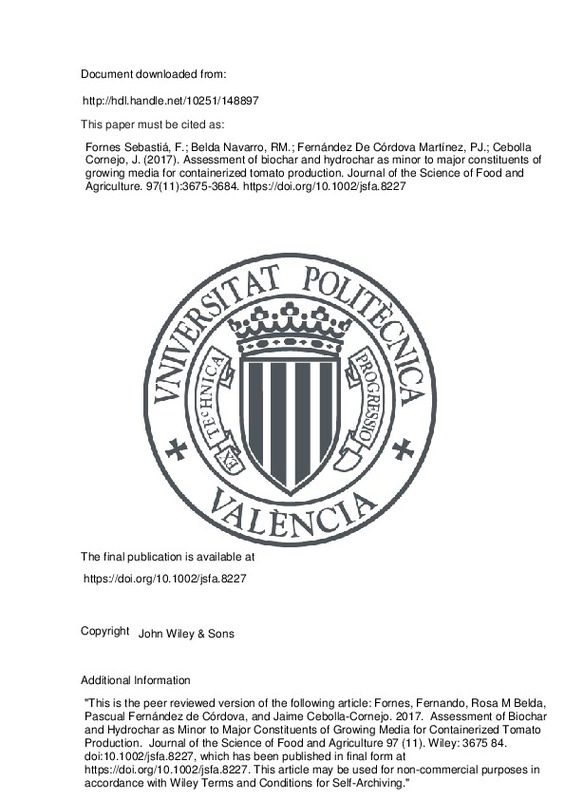Martí, R., Roselló, S., & Cebolla-Cornejo, J. (2016). Tomato as a Source of Carotenoids and Polyphenols Targeted to Cancer Prevention. Cancers, 8(6), 58. doi:10.3390/cancers8060058
Dorais, M., Ehret, D. L., & Papadopoulos, A. P. (2008). Tomato (Solanum lycopersicum) health components: from the seed to the consumer. Phytochemistry Reviews, 7(2), 231-250. doi:10.1007/s11101-007-9085-x
Schmilewski, G. (2009). GROWING MEDIUM CONSTITUENTS USED IN THE EU. Acta Horticulturae, (819), 33-46. doi:10.17660/actahortic.2009.819.3
[+]
Martí, R., Roselló, S., & Cebolla-Cornejo, J. (2016). Tomato as a Source of Carotenoids and Polyphenols Targeted to Cancer Prevention. Cancers, 8(6), 58. doi:10.3390/cancers8060058
Dorais, M., Ehret, D. L., & Papadopoulos, A. P. (2008). Tomato (Solanum lycopersicum) health components: from the seed to the consumer. Phytochemistry Reviews, 7(2), 231-250. doi:10.1007/s11101-007-9085-x
Schmilewski, G. (2009). GROWING MEDIUM CONSTITUENTS USED IN THE EU. Acta Horticulturae, (819), 33-46. doi:10.17660/actahortic.2009.819.3
Graber, E. R., Meller Harel, Y., Kolton, M., Cytryn, E., Silber, A., Rav David, D., … Elad, Y. (2010). Biochar impact on development and productivity of pepper and tomato grown in fertigated soilless media. Plant and Soil, 337(1-2), 481-496. doi:10.1007/s11104-010-0544-6
Dumroese, R. K., Heiskanen, J., Englund, K., & Tervahauta, A. (2011). Pelleted biochar: Chemical and physical properties show potential use as a substrate in container nurseries. Biomass and Bioenergy, 35(5), 2018-2027. doi:10.1016/j.biombioe.2011.01.053
Vaughn, S. F., Kenar, J. A., Thompson, A. R., & Peterson, S. C. (2013). Comparison of biochars derived from wood pellets and pelletized wheat straw as replacements for peat in potting substrates. Industrial Crops and Products, 51, 437-443. doi:10.1016/j.indcrop.2013.10.010
Steiner, C., & Harttung, T. (2014). Biochar as a growing media additive and peat substitute. Solid Earth, 5(2), 995-999. doi:10.5194/se-5-995-2014
Petruccelli, R., Bonetti, A., Traversi, M. L., Faraloni, C., Valagussa, M., & Pozzi, A. (2015). Influence of biochar application on nutritional quality of tomato (Lycopersicon esculentum). Crop and Pasture Science, 66(7), 747. doi:10.1071/cp14247
Libra, J. A., Ro, K. S., Kammann, C., Funke, A., Berge, N. D., Neubauer, Y., … Emmerich, K.-H. (2011). Hydrothermal carbonization of biomass residuals: a comparative review of the chemistry, processes and applications of wet and dry pyrolysis. Biofuels, 2(1), 71-106. doi:10.4155/bfs.10.81
Fornes, F., Belda, R. M., & Lidón, A. (2015). Analysis of two biochars and one hydrochar from different feedstock: focus set on environmental, nutritional and horticultural considerations. Journal of Cleaner Production, 86, 40-48. doi:10.1016/j.jclepro.2014.08.057
Kuzyakov, Y., Subbotina, I., Chen, H., Bogomolova, I., & Xu, X. (2009). Black carbon decomposition and incorporation into soil microbial biomass estimated by 14C labeling. Soil Biology and Biochemistry, 41(2), 210-219. doi:10.1016/j.soilbio.2008.10.016
Bargmann, I., Martens, R., Rillig, M. C., Kruse, A., & Kücke, M. (2013). Hydrochar amendment promotes microbial immobilization of mineral nitrogen. Journal of Plant Nutrition and Soil Science, 177(1), 59-67. doi:10.1002/jpln.201300154
Bargmann, I., Rillig, M. C., Buss, W., Kruse, A., & Kuecke, M. (2013). Hydrochar and Biochar Effects on Germination of Spring Barley. Journal of Agronomy and Crop Science, 199(5), 360-373. doi:10.1111/jac.12024
Akhtar, S. S., Li, G., Andersen, M. N., & Liu, F. (2014). Biochar enhances yield and quality of tomato under reduced irrigation. Agricultural Water Management, 138, 37-44. doi:10.1016/j.agwat.2014.02.016
Vaccari, F. ., Maienza, A., Miglietta, F., Baronti, S., Di Lonardo, S., Giagnoni, L., … Genesio, L. (2015). Biochar stimulates plant growth but not fruit yield of processing tomato in a fertile soil. Agriculture, Ecosystems & Environment, 207, 163-170. doi:10.1016/j.agee.2015.04.015
Cortés-Olmos, C., Valcárcel, J. V., Roselló, J., Díez, M. J., & Cebolla-Cornejo, J. (2015). Traditional Eastern Spanish varieties of tomato. Scientia Agricola, 72(5), 420-431. doi:10.1590/0103-9016-2014-0322
Fornes, F., Belda, R. M., Carrión, C., Noguera, V., García-Agustín, P., & Abad, M. (2007). Pre-conditioning ornamental plants to drought by means of saline water irrigation as related to salinity tolerance. Scientia Horticulturae, 113(1), 52-59. doi:10.1016/j.scienta.2007.01.008
Cebolla-Cornejo, J., Valcárcel, M., Herrero-Martínez, J. M., Roselló, S., & Nuez, F. (2012). High efficiency joint CZE determination of sugars and acids in vegetables and fruits. ELECTROPHORESIS, 33(15), 2416-2423. doi:10.1002/elps.201100640
Cebolla-Cornejo, J., Roselló, S., Valcárcel, M., Serrano, E., Beltrán, J., & Nuez, F. (2011). Evaluation of Genotype and Environment Effects on Taste and Aroma Flavor Components of Spanish Fresh Tomato Varieties. Journal of Agricultural and Food Chemistry, 59(6), 2440-2450. doi:10.1021/jf1045427
Dunlop, S. J., Arbestain, M. C., Bishop, P. A., & Wargent, J. J. (2015). Closing the Loop: Use of Biochar Produced from Tomato Crop Green waste as a Substrate for Soilless, Hydroponic Tomato Production. HortScience, 50(10), 1572-1581. doi:10.21273/hortsci.50.10.1572
Bunt, A. C. (1988). Media and Mixes for Container-Grown Plants. doi:10.1007/978-94-011-7904-1
Mukherjee, A., & Zimmerman, A. R. (2013). Organic carbon and nutrient release from a range of laboratory-produced biochars and biochar–soil mixtures. Geoderma, 193-194, 122-130. doi:10.1016/j.geoderma.2012.10.002
Schulz, H., & Glaser, B. (2012). Effects of biochar compared to organic and inorganic fertilizers on soil quality and plant growth in a greenhouse experiment. Journal of Plant Nutrition and Soil Science, 175(3), 410-422. doi:10.1002/jpln.201100143
Fornes, F., Carrión, C., García-de-la-Fuente, R., Puchades, R., & Abad, M. (2010). Leaching composted lignocellulosic wastes to prepare container media: Feasibility and environmental concerns. Journal of Environmental Management, 91(8), 1747-1755. doi:10.1016/j.jenvman.2010.03.017
[-]







![[Cerrado]](/themes/UPV/images/candado.png)


